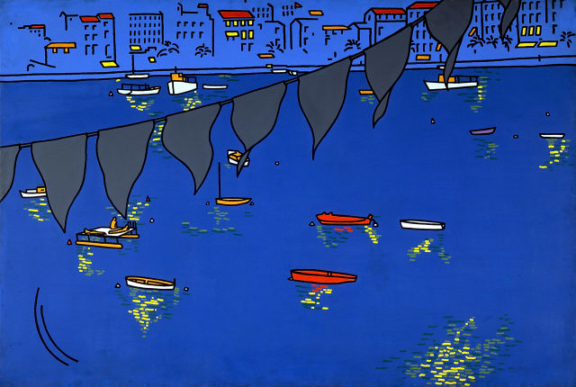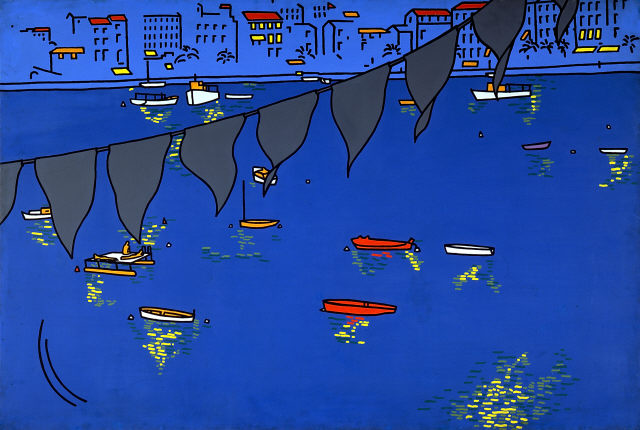
- 1964
- Cardboard
- Oil
- Inv. PE250
Patrick Caulfield
View of the Bay
In the context of a piece which appears to be associated with the pop world mainly due to the rejection of the authorial identity in the gesture of painting, View of the Bay shows us the formal characteristics which will identify the artists’ work up until the end of the 1970s: the saturation of the picture surface with flat, dense colours and the outlining of the forms with a heavy black line. The latter characteristic, which he would abandon for being a resource which facilitated artistic thought and denounced authorship, can link him to Roy Lichtenstein. But his thematic position is completely different, herein resting his main argument for rejecting the pop label. Patrick Caulfield, who in the summer of 1960 travelled through Greece, Italy and France, attempted to bring the European pictorial tradition up to date, identifying its main themes to be the painting of landscapes, interiors and still lifes.
With rare exceptions, the absence in his compositions of not only the face, but also of the human figure, seems to summon the spectator capturing him in the reality presented, in an apparent neutrality which encourages the contemplation of things as they are in the painting. Thus, abiding by something which seems to be a recurrent theme in his work: attention to the reception of the work. In this case, the dominance of the garland which diagonally crosses the canvas is telling. The wind, shown in an almost photographic manner, enhanced by the two curved lines in the lower left hand corner, and the darker shade of the blue of the garland, confirming the illumination of the bay, helps to evoke this embrace on the spectator which is uninterrupted by human figures, treated as just another element of the landscape which extends before us. This expansion of the pictorial plane is significant when we consider the painter’s original preference for square canvases as they are not automatically associated with panoramas, usually found on canvases which extend horizontally, or human figures usually found on vertical canvases.
Throughout his career, Caulfield used all the technical resources he possessed, critically analysing them and ensuring they met the intrinsic needs of each work. On this large horizontal surface, which corresponds to the formal needs of a landscape painting as understood by the painter, the relationship between the blues which distinguish the three main areas of the painting is illuminated through the use of reds, oranges, yellows and whites. We are transported to the memory of the French Riviera, reminding us of its geographical importance in modern art, thanks to the work developed there by painters such as Cézanne or Matisse.
André Silveira
May 2010
| Type | Value | Unit | Section |
| Depth | 3,3 | cm | |
| Height | 122 | cm | |
| Width | 183 | cm | |
| Height | 123,5 | cm | |
| Width | 184,5 | cm |
| Type | other |
| Type | signature |
| Type | other |
| Type | title |
| Type | Acquisition |
| A Ilha do Tesouro / Treasure Island |
| CAMJAP/FCG |
| Curator: CAMJAP/FCG |
| 7 de Fevereiro de 1997 a 4 de Maio de 1997 Todo o espaço expositivo do CAM - pisos 0, 1 e 01, e Galeria de Exposições Temporárias. |
| Comissários da exposição: Jorge Molder e Rui Sanches. |
| Metamorphosis - British Art of the Sixties: works from the collections of the British Council and the Calouste Gulbenkian Foundation |
| Basil & Elise Goulandris Foundation - Museum of Contemporary Art |
| Curator: Fleurette P. Karadontis |
| 26 de Junho de 2005 a 25 de Setembro de 2005 Basil & Elise Goulandris Foundation - Museum of Contemporary Art |
| Comissários da exposição: Richard Riley, British Council, London, e Ana Vasconcelos e Melo, CAMJAP-FCG, Lisboa. |
| British Pop |
| Museo de Bellas Artes de Bilbao |
| Curator: Marco Livingstone |
| 17 de Outubro de 2005 a 12 de Fevereiro de 2006 Museo de Bellas Artes de Bilbao |
| Exposição comissariada por Marco Livingstone. |
| 100 Obras de Arte Britânica Contemporânea |
| Fundação Calouste Gulbenkian |
| Curator: Fundação Calouste Gulbenkian |
Galeria de exposições temporárias, FCG |
| Exposição realizada em Janeiro 1971, na Galeria de exposições temporárias, FCG. |
| The Gulbenkian Foundation and British Art |
| Tate Britain |
| Curator: Tate Britain |
| 1 e 10 de Março de 2006 a Fevereiro de 2007 Londres, Tate Britain |
| A exposição fez parte das comemorações dos 50 anos da Fundação Calouste Gulbenkian que começaram oficialmente a 18 de Julho de 2006. |
